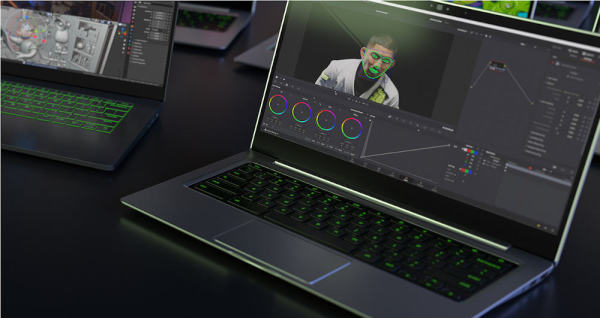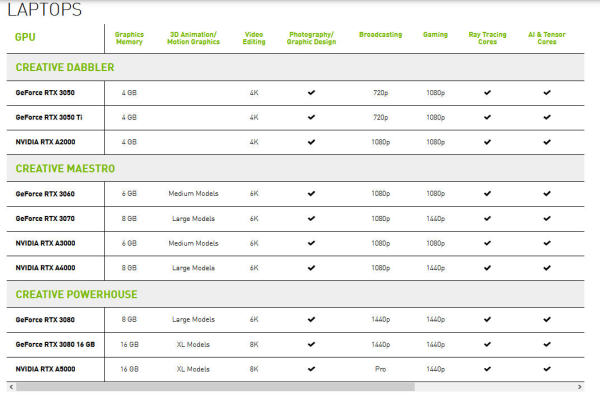Nvidia has introduced two new GPUs especially for mobile use with the GeForce RTX 3050 and RTX 3050 Ti. The new models complement the previously presented RTX 3060, 3070 and 3080 GPUs and target notebooks in the range of about 800 Euros and up with their rather low price and performance in comparison.

Both new models only have 4 GB of graphics memory on board (for comparison: the RTX 3060 has 6 GB, the RTX 3070 and 3080 8 GB), but in contrast to the last generation, they have all (albeit somewhat downscaled) features of the more powerful models: Tensor cores for machine learning, RT cores for ray tracing, the Ampere video unit for encoding and decoding via the AV1/HEVC codecs as well as Nvidia Broadcast software for streaming and Nvidia Reflex for gaming. HDMI 2.1 interfaces are also supported.
The GeForce RTX 3050 Ti is naturally a bit weaker equipped compared to the higher models and has, for example, about half of the shaders, texture mapping and render output units as well as tensor and ray-tracing cores of the GeForce RTX 3070 model with 2,560 / 80 / 48 / 80 / 20 - RTX 3050 even over 10-20% less. The size of the L2 cache (2 MB) as well as the clock rate and memory connection (with a bandwidth of 224 GB/s) is also lower. However, the power consumption benefits from this, which is only at a TDP of 35-80 watts - the range is so large because it completely depends on the respective implementation by the notebook manufacturer how strongly the graphics unit is cooled and thus how powerful it is. Experience shows that the thinner a laptop is, the worse the cooling of the GPU and thus the performance.

Feature comparison of the different RTX 3X models
For the gaming performance of the rather weaker new GPUs, Nvidia relies entirely on the strength of its DLSS (Deep Learning Super Sampling) algorithm with the help of the Tensor Cores to use a special trick to increase the frame rates (fps) that are important in games. The games are run at a lower resolution with a higher frame rate and then - visually almost imperceptibly - upscaled to a higher resolution (or artificially resharpened) in real time by AI. This works amazingly well - as long as the respective game supports it.
Probably the most interesting feature for video work is the hardware support of codecs, which significantly speeds up many everyday video editing tasks - as long as the codec used is supported by the RTX GPUS. Decidedly accelerated by the GPU as well as encoding/decoding via hardware and deep learning functions (like Adobe&s AI Auto Reframe or object removal in Resolve) are programs like Adobe After Effects, Adobe Premiere Pro, REDCINE-X PRO, Vegas Pro and Blackmagic&s DaVinci Resolve with the help of Nvidia&s Studio.

Acceleration in Adobe Premiere Pro and DaVinci Resolve
To coincide with the introduction of the new GPUs, a number of manufacturers have also unveiled  updated
updated  Nvidia Studio models of their respective notebook ranges with Nvidia RTX 3X GPUs as well as Intel&s 11th generation Tiger Lake H CPUs.
Nvidia Studio models of their respective notebook ranges with Nvidia RTX 3X GPUs as well as Intel&s 11th generation Tiger Lake H CPUs.

